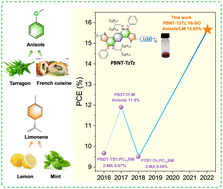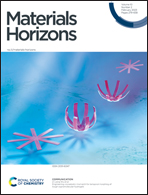High-efficiency organic solar cells processed from a real green solvent†
Abstract
The fabrication of organic solar cells (OSCs) depends heavily on the use of highly toxic chlorinated solvents, which are incompatible with industrial manufacturing. The reported alternative solvents such as non-halogenated aromatic hydrocarbons and cyclic ethers are also not really “green” according to the “Globally Harmonized System of Classification and Labelling of Chemicals” of the United Nations. Therefore, processing from real green solvents such as water, alcohols, or anisole will constitute a big breakthrough for OSCs. However, it is fundamentally challenging to obtain high-performance photovoltaic materials processable from these solvents. Herein, we propose the incorporation of a B–N covalent bond, which has a dipole moment of 1.84 Debye, into the conjugated backbone of polymer donors to fabricate high-efficiency OSCs from anisole, a real green and eco-compatible solvent recommended by the United Nations. Based on a newly developed B–N-based polymer, the OSCs with a record-high efficiency of 15.65% in the 0.04 cm2 device and 14.01% in the 1.10 cm2 device have thus been realized via real green processing.

- This article is part of the themed collection: 2024 Materials Horizons Lunar New Year collection


 Please wait while we load your content...
Please wait while we load your content...